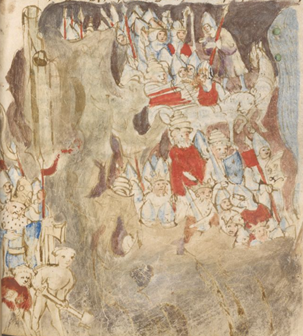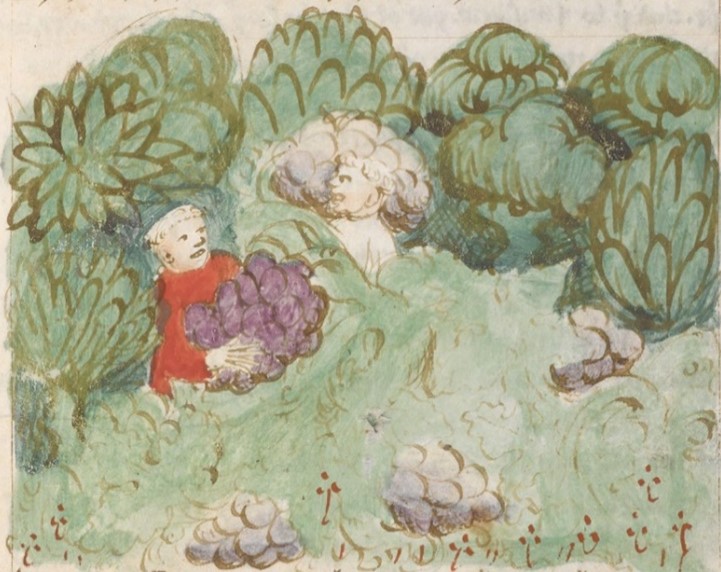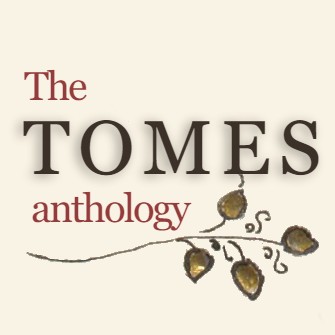Creating Our Own Edition of Mandeville's Travels
I am a third-year English BA student, and last year I contributed to the TOMES project during my Philology 4 course. Along with my teammate and friend Anna van der Mout, I transcribed, translated and analysed three folios of the Mandeville’s Travels. We had never heard of this medieval text before, but what we learned about it was fascinating. What drew us to the text in the first place was its seeming resemblance to the Canterbury Tales; both are, after all, travel narratives.
But the similarities apparently stopped there, and in hindsight the comparison was not very fitting. Travelling plays a relatively small role in the Canterbury Tales; the focus of the narrative is on a plethora of diverse narratives told by different characters (there is good reason why we now refer to the work as the Canterbury Tales, and not as the Canterbury Travels). Travelling plays a much bigger role in Mandeville’s Travels, which recounts, in a single narrative, one man’s journey around the world. The geographical scope of Mandeville’s Travels is much larger than that of the Canterbury Tales, and the former offers interesting insights into medieval views of other culture.
We started the project by selecting this text from a list of medieval texts supplied as part of the editorial project. Although few working on the project had extensive knowledge of the Travels prior to embarking upon the project, this text was still somehow very captivating, and many different groups chose it for their project (causing quite the alarm in the administrative system!). Thankfully, we were all allowed to work on Mandeville’s Travels; the text was long enough that each group could choose their own selection. The entire work was available in London, British Library Harley MS 3954, which has been digitised. This manuscript was quite extraordinary; aside from Mandeville’s Travels, it contains religious poetry – including work by William Langland – and 99 coloured illustrations!
After the first step of deciding on a text to work on, we next had to decide which passage to transcribe. Because the Travels had so much to offer, this was quite challenging. We eventually settled on what would later reveal itself to be a very interesting section, namely: ff. 52v – 53v. This section contained the two illustrations shown below, which are taken from the digitised manuscript at: http://www.bl.uk/manuscripts/Viewer.aspx?ref=harley_ms_3954_fs001r:

After receiving instruction about the process of transcribing, we set to work on the task at hand. Around this time, we were in the first lockdown of the Covid crisis. My teammate and I first divided the work in half, and after we’d finished our individual work, we had a very long Skype call in which we went through the entire piece together, discussing all the little ambiguities we found. It was quite the challenge, as there wasn’t a good reference transcription or translation available, and the scribe used a lot of abbreviations that looked rather strange. Thankfully, through our discussions we could resolve a lot of uncertainties, and any remaining questions were answered by our tutors Krista Murchison and Amos van Baalen when they hosted a Q and A session. Looking back on the experience, it was actually very rewarding that we ended up working on a complicated text with no reference text. It really forced me to look things over for the fourth or fifth time and as I progressed, the puzzle of archaic letter forms and abbreviations went from frustratingly difficult to pleasantly challenging. The scribe, who copied this text over 500 years ago, started out as a total stranger, but became more and more familiar as I worked.
Once the transcription was made, checked, edited, and checked again, it was time to start translating it! This was a challenge yet again, as our now familiar scribe made quite a number of language mistakes (inasmuch as one can speak of language mistakes in text created before standardised language course; perhaps I should instead call them ‘rather-eccentric-spelling-choices-that-are-not-listed-as-possible-alternative-spellings-for-words-in-the-Middle-English-Dictionary’). For example, the scribe used “þowr” as an alternative spelling of thurgh, and “p(er)ther” and “oþir” as alternative spellings for other. We got there in the end though!

In our passage, John Mandeville describes the kingdom of Caldylle, which lies between Catay and southern Asia. In this land, the most extraordinary fruit grows. First of all, there is a cucumber-like fruit, which contains “a beast in there of flesh and bone and blood, as [if] it were a little lamb without wool.” But that is not all, there are also “trees that bear fruit, which become flying birds […] And those that fall in the water live and those that fall on the ground die.” Then some less fanciful trees are described; these bear “cloves, nutmeg and cinnamon and many other spices.” Mandeville’s Travels finishes this description of the Caldyllic vegetation with a bang though; “there are vines that bear such great grapes that a strong man can only bear one bunch of them.” These grapes are also illustrated.
But the kingdom of Caldylle does not contain super-fruit alone; there are also the hills of Caspye, in which “Gog and Magog are enclosed, and they may not go out at any side, and 22 kings and their people are enclosed there” (illustrated in the image above). Here, the text draws on a longer medieval tradition of conflating the biblical Gog and Magog with Jewish people. The text gives a remarkably hostile description of these Jewish people, which scholars have argued is reflective of broader anti-Semitism in Europe at the time.
At the final stage of the project, we were to write an introduction to Mandeville’s Travels, covering its history, content, language, copying, transmission, and our particular passage. To accomplish this, we had to turn to secondary scholarly material. Thankfully, a lot has been published about Mandeville’s Travels over the years, and we had to be mindful not to write too much! For bibliographical references in the introduction and for the formatting of the entire work, we learned how to use TEI web mark up. This seemed quite daunting at first, but turned out to be a simple matter of looking up the right code for your comment type, and filling in the particulars. After a final round of feedback, we handed in our contribution for the TOMES project. Hopefully future students can profit from it, and will be as initially confused and subsequently fascinated by the text as we were!
Carlijn Tetteroo
